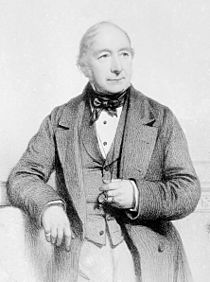Thomas Pettigrew facts for kids
Quick facts for kids
Thomas Joseph Pettigrew
|
|
|---|---|
 |
|
| Born | 28 October 1791 |
| Died | 23 November 1865 |
| Nationality | British |
| Known for | unwrapping mummies |
| Scientific career | |
| Fields | Egyptology, surgery |
Thomas Joseph Pettigrew (born October 28, 1791 – died November 23, 1865) was a British surgeon and a person very interested in old things, known as an antiquarian. He became a top expert on ancient Egyptian mummies. People in London often called him "Mummy" Pettigrew because he was famous for unwrapping mummies at special events. He would carefully examine them to learn more about ancient times.
Contents
Thomas Pettigrew's Early Life
Thomas Joseph Pettigrew was born in London on October 28, 1791. His father, William Pettigrew, was also a surgeon. He had worked as a doctor on a ship called HMS Victory.
From a young age, Thomas was very curious about the human body. He even practiced examining bodies when he was young. At sixteen, he became an apprentice to a surgeon named John Taunton. He helped Taunton with his medical work and at his anatomy school.
In 1808, when Thomas was seventeen, he joined a group of curious young people. They formed the City Philosophical Society. Thomas gave his first lecture there about the human mind. Later, Michael Faraday, a famous scientist, helped Thomas. Faraday used chemistry to study minerals found inside mummies.
Pettigrew's Career as a Surgeon
Thomas Pettigrew started his career by becoming a secretary for medical groups. These jobs helped him become a surgeon for important people. He worked for the Duke of Sussex and the Duke of Kent. He even gave the future Queen Victoria her vaccination when she was a child.
He also worked at several hospitals and clinics. These included a children's hospital and a hospital that later became Charing Cross Hospital. At Charing Cross Hospital, Pettigrew taught about the human body and surgery. He even did some of his first mummy unwrappings there.
In 1836, he left the hospital and started his own private medical practice. He lived in Savile Row, a famous street in London.
Pettigrew's Love for Ancient History
Thomas Pettigrew was always interested in old things and the history of medicine. He kept these interests throughout his life. Because of this, he joined many important groups. These groups studied science, history, and ancient objects.
He was a founding member of the British Archaeological Association. At their first meeting in 1844, he unwrapped a mummy for everyone to see. This was a very popular event! He continued to be a leader in this group until he passed away. He was also a well-known Freemason for many years.
Pettigrew was active in the smart society of his time. He wrote letters to many famous people. These included doctors, scientists, writers, and artists. Some of them were Michael Faraday and Charles Dickens.
Thomas Pettigrew's Family Life
In 1811, Thomas Pettigrew married Elizabeth Reed. They had twelve children together, and eight of them grew up. His son, Dr. William Vesalius Pettigrew, often helped him unwrap mummies.
Another son, Samuel Thomas Pettigrew, became a religious leader in India. He helped start important schools and churches there. These included Bishop Cotton Boys' School and Bishop Cotton Girls' School.
After his wife died in 1854, Thomas Pettigrew stopped working as a doctor. He spent all his time on his interest in ancient history. He passed away in 1865 at the age of 74. He is buried in Brompton Cemetery in London.
Images for kids



